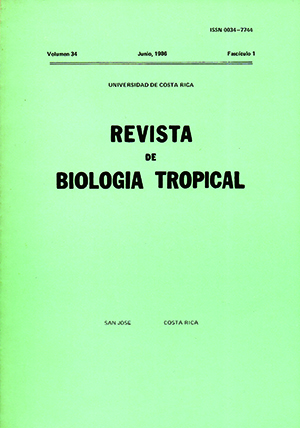Abstract
Ascochyta phaseolorum and Pseudomonas sp. were isolated from infected Sechium edule fruits collected in the Valley of Ujarrás, Costa Rica. Young and mature healthy fruits were inoculated with suspensions of fungus spores or bacteria and placed in humid chambers in the laboratory or in the greenhouse. Only the young fruits from the laboratory developed lesions. The lesions produced by the fungus are characterized by rupture and lysis of the epidermal cell walls, with posterior invasion of the mesocarp parenchyma and the vascular tissues. In general, tissue destruction is correlated to the size of the lesion; the infection may even cause rotting of the fruit. Bacterial lesions showed thickening of the walls of the surrounding cells, as well as cytoplasm granulation and inclusions of crystalline formations. Bacteria were not observed inside the wound. There was no difference between natural lesions in the fruits collected in the field and those induced in the laboratory.References
Agrios, G.N. 1978. Plant Pathology. Academic Press, New York.
Aung, L. & G. Flik. 1976. Gibberellin induced seedless fruit of chayote Sechium edule Swartz. Hort. Sci., 11: 460-462.
Baker, L.J. & D. Bateman. 1978. Cutin degradation by plant pathogenic fungi. Phytopath., 68: 1577-1584.
Brewer, D. 1960. Studies in Ascochyta pisi Lib. Can. J. Bot., 38: 705-717.
Fernández, M. 1952. Introducción a la fitopatología. 2nda. ed. Talleres Gráficos Gadola, Buenos Aires, Argentina. 872 p.
Gaudel, D.A. & E.G. Kokko. 1984. Application of Scanning Microscopy to paraffin - embedded plant tissues to study invasive processes of plant patogenic fungi. Phytopath., 74: 1078-1080.
González, L.C. 1976. Introducción a la fitopatología. San José, Costa Rica, Ed. Instituto Interamericano de Ciencias Agrícolas. 148 p.
Hayward, A.C. 1974. Latent infections by bacteria. Ann. Rev. Phytopath., 12: 87-97.
Hirano, S. 1983. Ecology and epidemiology of foliar bacterial plant pathology. Ann. Rev. Phytopath., 21: 243-269.
Jaroz, A.M., M. Sheets & M. Levy. 1982. Cuticle tickness in Phlox and resistance to powdery mildew: an unreliable line of defense. Amer. J. Bot., 6: 824-828.
Johansen, D.A. 1940. Plant microtechnique. Mc-GrawHill Book Co., New York. 523 p.
Kuc, J. 1982. The inmunization of cucurbits against fungal, bacterial and viral diseases. In: Asada, Y. et al. Plant Infection. Japan Scientific Societies Press. Tokyo. p. 137-1 53.
Kunoh. H. 1982. Primary Germ Tubes of Erisiphe graminis conidia. In: Asada, Y. et al. Plant Infection. Japan Scientific Societies Press, Tokyo. p. 45-59.
Leben. C. 1981. How plant-pathogenic bacteria survive. Plant Disease, 65: 633-637.
León, J. 1968. Fundamentos botánicos de los cultivos tropicales. Ed. Instituto Interamericano de Ciencias Agrícolas, Lima, Perú. 487 p.
Martin, J.T. & B.E. Juniper. 1970. The cuticles of plants. Edward Arnold (Publishers) Ltd., New York. 347 p.
Medina, J. 1969. Una planta totalmente comestible? El Surco Latinoamericano, Nov-Dic. p. 17.
Núñez, E. 1978. Plantas medicinales de Costa Rica y su folclore. Segunda edición. Ed. Univ. Costa Rica, San José, Costa Rica. 318 p.
Reshtnikova, LA. & G.D. Upenskaya. 1979a. Pectolitic enzymes of Ascochyta specics. Biologisches kie Nauki (U.R.S.S.) N6, 97-100. 1978. Compendiado en Rev. Plant Path., 58: 1060.
Reshtnikova. I.A. & G.D. Upenskaya. 1979b. Enzyme activity of Ascochyta cucumerines. Hiologiya (U.R.S.S.). N2: 47-50. 1978. Compendiado en Rev. Plant Path., 58: 1441.
Ride, J.P. 1980. The effect of induced lignification of the resistance of wheat cell walls to fungal degradatin. Physiol. Plant Path., 16: 187-196.
Sáenz, M. V. 1985. Identificación y estacionalidad de los factores de rechazo de frutos de exportación del chayote (Sechium edule SW) costarricense. Tesis de grado de Ingeniero Agrónomo. Universidad de Costa Rica. Facultad de Agronomía, Escuela de Fitotecnia. 104 p.
Sarasola, A. & M.A. Rocca. 1975. Fitopatología. Editorial Hemisferio Sur, Buenos Aires, Argentina. 364 p.
Sharman, B.C. 1943. Tanic acid and iron alum with safraning and orange G in studies of the shoot apex. Stain Tech., 18: 105-111.
Sherwood, R. & C.P. Vance. 1982. lnitial events in the epidermal layer during penetration. In: Asada, Y. et al. eds. Plant infection. Japan Scientific Societies Press, Tokyo. p. 27-44.
Shrivastrava, R.C. 1982. Fungi causing plant diseases at jampur. lndian Phytopath., 33: 221-224. Compendiado en Rev. Plant Path., 61: 4774.
Singh, B. 1965. Ovule and seed of Sechium edule Sw. A reinvestigation. Current Sci. 34: 696-697.
Steekelenburg, N.A. van. 1978. Chemical control of Didymiela bryoniae (Ascochyta cucumerines) in cucumbers. Netherland J. Plant Path. 84: 27-34. Compendiado en Rev. Plant Path., 5: 3691.
Steekelenburg, N.A. van. 1982. Factors influencing external fruit rot of cucumber caused by Didymiella bryoniae. Nethcrlands J. Plant Path. 88(2): 47-56. 1981. Compendiado en Microbiological Abstracts (U. S.A.) Serie A: Industrial and Applied Microbiology, 17: 5249-A.
Suborós, J.F. 1984. Estudio morfológico de la antracnosis en tallos y hojas de guanábana (Annona muricata L.) causados por Colletotrichum gloeosesporioides Tenz. Tesis de grado de Ingeniero Agrónomo. Universidad de Costa Rica, Facultad de Agronomía. Escuela de Fitotecnia. 52 p.
Uspenskaya, G. & LA. Reshtnikoya. 1981. Cellulotic enzymes of Ascochyta and Phoma. Mikologiya i Fitopatologiya (U.R.S.). 15: 27-32. Compendiado en Rev. Plant Path., 61: 5714.
Vance, C.P. & T.K. Kirk. 1980. Lignification as a mechanism of disease resistance. Ann. Rev. Phytopath., 18: 259-288.
Wynn, W. 1976. Aprresorium formation over stomates by the bean rust fungus: Response to a surface contact stimulus. Phytopath., 66: 136-146.
##plugins.facebook.comentarios##

This work is licensed under a Creative Commons Attribution 4.0 International License.
Copyright (c) 1986 Revista de Biología Tropical


